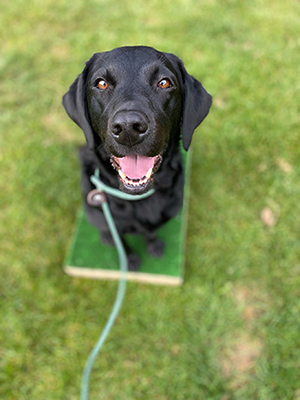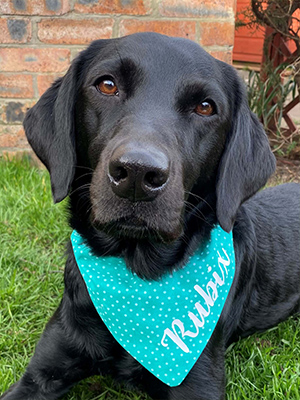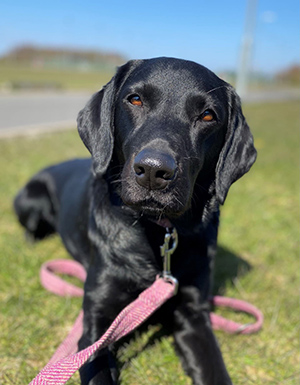Rubix is a 5 year old, black Labrador bitch. She initially attended the regenerative medicine department at Greenside as a second opinion when she was 3 years old.
In April of 2019, Rubix had an incident where she ran into her owner at speed. Following this, she had a right hind limb lameness. After visiting a primary care vet and a specialist vet, she was given a differential diagnosis of a soft tissue injury and prescribed rest and rehab. Over the next 10 months, Rubix exhibited stiffness after exercise and was restricted to 20 minutes on lead twice daily. She also started to exhibit some behavioural changes with anxiety and hiding.
Holistic Diagnosis
In February of 2020 at Greenside, Rubix was diagnosed with a chronic injury and tear of the right iliacus muscle. This muscle joins with the psoas major muscle to form the iliopsoas muscle complex – a key component in the action of flexing the hip joint. This explained the right hind lameness and stiffness she had been exhibiting. Musculoskeletal ultrasound was used to diagnose this injury as physical exam found the iliopsoas to be in spasm and a pain response was elicited on palpation. Despite the primary issue being detected in the right hind limb, on physical exam Andy also found poor shoulder muscle coverage, a resentment to right shoulder extension, resentment to tail hyperextension, sensitivity to pressure at the lumbosacral junction, resentment to hip abduction and right sciatic sensitivity. It was important to obtain a full diagnosis of all affected areas so that an appropriate treatment plan could be created to target all areas of pathology.
 Therefore, radiographs were also taken of Rubix’s elbows, shoulders, hips and lumbar spine. She also had musculoskeletal ultrasound of her shoulders and caudal lumbar discs to visualise the soft tissue structures that may be compromised here.
Therefore, radiographs were also taken of Rubix’s elbows, shoulders, hips and lumbar spine. She also had musculoskeletal ultrasound of her shoulders and caudal lumbar discs to visualise the soft tissue structures that may be compromised here.
Following her diagnostic tests, Rubix was also diagnosed with elbow and hip dysplasia, lumbosacral disease and shoulder tendinopathies alongside her chronic iliopsoas muscle injury.
Quantitative objective measurements were also taken using force plate analysis, stance analysis, gulick and goniometry measurements and LS pain algometry. Findings were consistent with offloading of the right fore and right hind and a shortened stride length of the right side. She had 2cm less muscle mass on her right hind compared to her left and 0.5cm less muscle on her right fore when compared to her left.
Andy was concerned that the iliopsoas injury had not healed in the 10 months post injury, but suspected that the extensive scar tissue was causing repeat injury. The changes in both hips and LS junction were mild and the latter was most likely due to the previous injury and subsequent unbalancing in the pelvic limbs. The subtrochlear sclerosis noted on the elbow x-rays could indicate mild elbow dysplasia or the previous trauma and the shoulder tendinopathies were likely secondary to this in combination with pelvic limb offloading.
Rubix's Treatment
Initially, non-steroidal anti-inflammatory medication and muscle relaxants were prescribed for Rubix. Options for management of these conditions would be to continue conservative management alongside medical management, regenerative medicine, or if there was no improvement an iliopsoas tenotomy would need to be considered.
 Due to the poor response to conservative management in the first instance, Rubix’s owner opted to pursue regenerative medicine to provide a holistic approach to manage both primary and secondary issues for Rubix. Managed conservatively, muscle strains usually recover with around 60% of their original tensile strength (Jarvinen et al., 2013). This is due to the scar tissue that is laid down being more inelastic than that of the original muscle fibres. However, as Rubix’s initial injury had occurred 10 months prior to treatment, there was extensive scar tissue from what was likely repetitive reinjury and the iliacus had been partially torn from its attachment to the ilium. By using stem cells, it was hypothesised that healing and tissue repair would be accelerated due to their ability to differentiate into the surrounding tissue cells and recruit other cell processes to promote healing. This would prevent reinjury due to the improved fibre pattern of the muscle and tendon. However, due to the extent of Rubix’s injury it was suggested that the iliopsoas was rescanned at 12 weeks post initial implantation to assess healing, and a second treatment of stem cells could be administered if necessary.
Due to the poor response to conservative management in the first instance, Rubix’s owner opted to pursue regenerative medicine to provide a holistic approach to manage both primary and secondary issues for Rubix. Managed conservatively, muscle strains usually recover with around 60% of their original tensile strength (Jarvinen et al., 2013). This is due to the scar tissue that is laid down being more inelastic than that of the original muscle fibres. However, as Rubix’s initial injury had occurred 10 months prior to treatment, there was extensive scar tissue from what was likely repetitive reinjury and the iliacus had been partially torn from its attachment to the ilium. By using stem cells, it was hypothesised that healing and tissue repair would be accelerated due to their ability to differentiate into the surrounding tissue cells and recruit other cell processes to promote healing. This would prevent reinjury due to the improved fibre pattern of the muscle and tendon. However, due to the extent of Rubix’s injury it was suggested that the iliopsoas was rescanned at 12 weeks post initial implantation to assess healing, and a second treatment of stem cells could be administered if necessary.
Once this course of treatment had been decided on, Rubix returned a week after her diagnostics for a falciform fat harvest in order to culture adipose derived stem cells. After 6 weeks of culture and growth of stem cells at the lab, Rubix returned to Greenside for stem cell implantation alongside platelet rich plasma. All areas of pathology were treated in order to treat her holistically: elbows, shoulders, hips, lumbosacral joint, supraspinatus and iliopsoas tendons and the right iliacus muscle. A course of laser therapy followed her implants to energise the stem cells stimulate the healing process. She was restricted in her exercise for 6 weeks with lead walks only.
She returned 6 weeks later for a physical exam with Andy to assess her progress. Her objective measurements had improved with symmetrical gulick measurements through her forelimbs and now only 1 cm difference between her hind limbs, with the right hind still slightly weaker. On exam, she had full joint range of motion and no areas of discomfort. Pressure algometry was normal and there was no pain elicited on iliopsoas palpation.
Following this fantastic improvement in Rubix, her pain medication was stopped and over the next 6 weeks she would undergo physiotherapy and hydrotherapy to aid in her rehabilitation. 12 weeks after initial implantation she returned for repeat scans of the shoulders and iliopsoas tendons to assess healing. Both the shoulder and iliopsoas tendons had normal fibre patterns at this stage. The chronic scar tissue in her right iliacus had remodelled and there were no longer any restrictions in her range of motion. The second treatment of stem cells in her iliopsoas was therefore not needed at this stage.
Over the next year, Rubix would undergo rehabilitation at greenside receiving both physiotherapy and hydrotherapy. Initially weekly sessions, this was quickly tailored down to fortnightly and then monthly sessions to maintain her musculoskeletal health. She also had a tailored home exercise programme that her owner completed religiously at home.
Rubix had a short sedation at her first visit to Greenside in order for diagnostic tests to be carried out. For her falciform fat harvest she was under general anaesthetic but on her return for implantation of stem cells she had another sedation. These three procedures were minor in comparison to what she would have had to undergo had she been subjected to an iliopsoas tenotomy (cutting the tendon). Because all of Rubix’s conditions could be treated at once with stem cell therapy, the procedure is fairly non-invasive and the recovery period is also minor in comparison to the average orthopaedic surgery. There was no cage rest involved, just 2 weeks of rest followed by a gradual increase in exercise, increasing each walk by 10 minutes per walk per week.
The uniqueness of Rubix’s case came from her chronic and quite severe iliopsoas injury. However, the response to this injury from the stem cells was fantastic. Her muscle tear recovered fully following one treatment of stem cells injected into the site of injury.
What was the length of recovery and how successful was the outcome?
6 weeks after initial stem cell implantation, Rubix was on better form than she had been in the 10 months leading up to her visit to Greeenside. She was off all pain medication and walking 40 minutes twice daily. However, it was at 12 weeks post implantation when scans revealed good soft tissue healing that Rubix was able to return to unrestricted exercise.
 Patients that have undergone stem cell therapy continue to be supported by the team at Greenside. Andy reassess his cases every 6 months after initially signing them off, and many cases, including Rubix, see the physiotherapists for maintenance sessions monthly or 8 weekly. Despite stem cell therapy reversing the disease process of osteoarthritis, the disease will inevitably progress and physiotherapy including lifestyle changes looks to slow down this progression. However, it is expected that patients will likely need more stem cell treatments throughout the course of their lifetime as the disease progresses.
Patients that have undergone stem cell therapy continue to be supported by the team at Greenside. Andy reassess his cases every 6 months after initially signing them off, and many cases, including Rubix, see the physiotherapists for maintenance sessions monthly or 8 weekly. Despite stem cell therapy reversing the disease process of osteoarthritis, the disease will inevitably progress and physiotherapy including lifestyle changes looks to slow down this progression. However, it is expected that patients will likely need more stem cell treatments throughout the course of their lifetime as the disease progresses.
18 months after her initial treatment, Rubix’s owner was still really pleased with her. There were no notable problems at home and she was exercising well with no medical management. At a 6 month review in November 2021, Andy noted a reduced muscle mass over Rubix’s supraspinatus muscles, and the right side had atrophy. This also correlated with a resistance to right shoulder extension. Musculoskeletal ultrasound confirmed some fibrosis of the supraspinatus tendons and some hypoechoic change in the right biceps tendon. Although clinically Rubix was doing well in other treated areas, Andy suspected there was some sub clinical deterioration resulting in overloading of the forelimbs and subsequent shoulder tendinopathies. For this reason, the shoulder tendons were treated with stem cells at the time of scanning and a blood sample was taken to culture more stem cells to re-treat the elbows, hips and lumbosacral joint.
12 weeks after shoulder implantation, the shoulders were improving but this was potentially unmasking hip and LSJ deterioration as range of motion of the right hip was sore and there was discomfort on lumbosacral joint pressure. As planned, the elbows, hips and lumbosacral joint were given a second stem cell treatment.
Rubix has recovered well and is now due her 6 week check up with Andy. Hopefully at this point she will resume normal activity but continue to be supported by the rehab team. We will reintroduce regular hydrotherapy to help rebuild her muscles and create her a tailored home exercise programme. Despite resolving her initial presenting complaint of an iliopsoas injury, Rubix’s other conditions will be managed throughout her lifetime. She will continue to be supported by the team at Greenside Vets to maintain optimum health and mobility.


